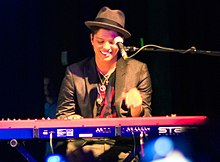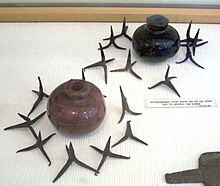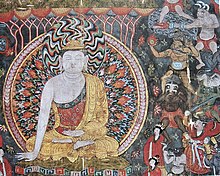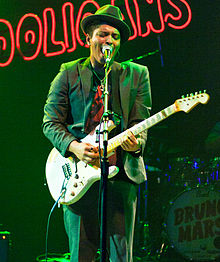Peter Gene Hernández (born October 8, 1985), known by his stage name
Bruno Mars, is an American singer-songwriter and record producer. Raised in
Honolulu,
Hawaii, by a family of musicians, Mars began making music at a young
age and performed in various musical venues in his hometown throughout
his childhood. He graduated from high school and then moved to Los
Angeles, California to pursue a musical career. Mars produced songs for
other artists, joining production team
The Smeezingtons.
Mars had an unsuccessful stint with
Motown Records, but then signed with
Atlantic Records in 2009. He became recognized as a solo artist after lending his vocals and co-writing the hooks for the songs "
Nothin' on You" by
B.o.B, and "
Billionaire" by
Travie McCoy. He also co-wrote the hits "
Right Round" by
Flo Rida featuring
Ke$ha, and "
Wavin' Flag" by
K'naan. In October 2010, he released his debut album,
Doo-Wops & Hooligans. Anchored by the worldwide number-one singles "
Just the Way You Are" and "
Grenade", the album peaked at number three on the
Billboard 200.
[2] Mars was nominated for seven
Grammys at the
53rd Grammy Awards, winning Best Male Pop Vocal Performance for "Just the Way You Are". His second studio album,
Unorthodox Jukebox, was released on December 11, 2012.
Mars' music is noted for displaying a wide variety of styles and
influences, and contains elements of many musical genres. He has worked
with an assortment of artists from various genres. As a child, he was
highly influenced by artists such as
Little Richard,
[3] Elvis Presley and
Michael Jackson and would often impersonate these artists from a young age. Mars also incorporates
reggae and
Motown
inspired sounds into his work. Worldwide, Mars became the best-selling
digital artist in 2011. He had three singles in the top ten, including
first place with "Just the Way You Are," which sold 12.5 million copies.
[4] Mars won Best International Male Solo Artist at the
2012 BRIT Awards.
[5] Bruno Mars has sold 6 million albums and 40 million singles worldwide.
Life and career
1985–2003: Early life and musical beginnings
Bruno Mars was born Peter Gene Hernández on October 8, 1985, in
Honolulu, Hawaii, and was raised in the
Waikiki neighborhood of Honolulu. He is the son of Peter Hernández and Bernadette "Bernie" San Pedro Bayot.
[7][8] His father is of half
Puerto Rican and half Jewish (from Hungary and Ukraine) descent, and is originally from
Brooklyn, New York.
[9][10] Mars' mother immigrated to Hawaii from the
Philippines as a child, and is of
Filipino and some Spanish descent.
[9][11][12] His parents met while performing in a show, where his mother was a
hula dancer and his father played percussion.
[10] At the age of two, he was nicknamed "Bruno" by his father, because of his resemblance to legendary professional wrestler
Bruno Sammartino.
[13][14][15]
Mars was one of six children and came from a musical family who exposed him to a diverse mix of
reggae, rock,
hip hop, and
R&B.
[16][17]
In addition to being a dancer, his mother was a singer and his father
used his musical ability to perform Little Richard rock n roll music.
[3]
Mars' uncle was an Elvis impersonator, and encouraged three-year-old
Mars to perform on stage as well. Mars also performed songs by artists
such as Michael Jackson,
The Isley Brothers, and
The Temptations.
[14]
At age four, Mars began performing five days a week with his family's
band, The Love Notes, in which he became known on the island for his
impersonation of Presley.
[18] In 1990, Mars was featured in
MidWeek as "Little Elvis", going on to have a cameo in the film
Honeymoon in Vegas in 1992.
[14][19]
His time spent impersonating Presley had a major impact on Mars' musical evolution and performing techniques.
[20] He later began playing guitar after drawing inspiration from
Jimi Hendrix.
[21]
In 2010, he also acknowledged his Hawaiian roots and musical family as
an influence, explaining, "Growing up in Hawaii made me the man I am. I
used to do a lot of shows in Hawaii with my father's band. Everybody in
my family sings, everyone plays instruments...I've just been surrounded
by it."
[22] In 2003, shortly after graduating from
President Theodore Roosevelt High School at the age of seventeen, Mars moved to Los Angeles, California, to pursue a musical career.
[14][19]
He adopted his stage name from the nickname his father gave him, adding
"Mars" at the end because "I felt like I didn't have [any] pizzazz, and
a lot of girls say I’m out of this world, so I was like I guess I'm
from
Mars."
[23]
2004–10: Production work and It's Better If You Don't Understand
I’d always been a working musician in Hawaii and never had problems
paying rent. And then it’s like, "Now I’m in L.A. and my phone’s getting
shut off." That’s when reality hit. I started DJing. It was something
silly. I told this person I could DJ because they said they could pay me
$75 cash under the table. I didn’t know how to DJ. I lost that job
pretty quick.
“
”
– Mars, speaking about his experiences of moving to Los Angeles to pursue a musical career.
[24]
Shortly after moving to Los Angeles, Mars signed to
Motown Records in 2004, in a deal that "went nowhere".
[25]
However, Mars' experience with Motown proved to be beneficial to his
career when he met songwriter and producer Philip Lawrence, who was also
signed to the label. Mars, Lawrence, and engineer Ari Levine began
writing songs together, and formed the production team
The Smeezingtons.
[25] In 2006, Lawrence introduced Mars to his future manager at
Atlantic Records, Aaron Bay-Schuck.
[26]
After hearing him play a couple of songs on the guitar, Bay-Schuck
wanted to sign him immediately, but it took about three years for
Atlantic records to finally sign Mars to the label.
[26] In the meantime, Bay-Schuck hired Mars and the Smeezingtons to write and produce songs for the label's artists.
[26] According to Bay-Schuck in an interview with
HitQuarters,
Mars had stated that although his ultimate goal was to be a solo
artist, he was willing to write and produce for other artists, both to
help improve his songwriting and help him discover the type of artist he
ultimately wanted to be.
[26] Bay-Schuck credits this as a period of "self-discovery" that contributed significantly to Mars' later success.
[26]
Before becoming a successful solo artist, Hernandez was an acknowledged music producer, writing songs for
Alexandra Burke,
Travie McCoy,
Adam Levine,
Brandy,
Sean Kingston, and
Flo Rida.
[16][24] He also co-wrote the
Sugababes' hit song "
Get Sexy" and provided backing vocals on their album
Sweet 7.
[27][28] His first musical appearance as a singer was in
Far East Movement's second studio album
Animal, featured on the track "3D".
[29] He was also featured on pastor and hip hop artist
Jaeson Ma's debut single "Love" in August 2009.
[30][31] He reached prominence as a solo artist after being featured on and co-writing
B.o.B's "
Nothin' on You" and Travie McCoy's "
Billionaire"; both songs peaked within the top ten of many charts worldwide.
[32][33][34][35]
He said of them, "I think those songs weren't meant to be full-sung
songs. If I'd sung all of "Nothin' on You", it might've sounded like
some
'90s R&B." Following this success, Mars released his debut
extended play (EP), titled
It's Better If You Don't Understand, on May 11, 2010.
[36] The EP peaked at the 99th position on the
Billboard 200 and produced one single, "The Other Side", featuring singers
Cee Lo Green and B.o.B.
[37][38] Mars collaborated with Green once more in August 2010 by co-writing his single "
Fuck You!" He performed a medley of "Nothin' on You" and "
Airplanes" with B.o.B and
Hayley Williams at the
2010 MTV Video Music Awards on September 12, 2010.
[39]
2010–2012: Doo-Wops & Hooligans
Bruno Mars' debut album,
Doo-Wops & Hooligans, was released digitally on October 4, and saw its physical release on October 5, 2010.
[40][41] The lead single, "
Just the Way You Are", was released on July 19, 2010,
[42] and has reached the top of the
Billboard Hot 100 as well as several other charts worldwide.
[43][44] The music video was released on September 8, 2010.
[45] The second single, "
Grenade", was released September 28, 2010, and has also seen successful international chart performance.
[46][47] In the United States,
Doo-Wops & Hooligans debuted at number three on the
Billboard 200 for the week of October 13, 2010, selling 55,000 copies.
[2] The album also received generally positive reviews from critics.
Entertainment Weekly's
Leah Greenblatt praised Mars for his "instant-access melodies" and "sly
snatches of dance-floor swagger", but noted weaknesses in songs deviant
from his conventional pop and soul genres.
[48] He opened for
Maroon 5 on the fall leg of the
Hands All Over Tour starting October 6, 2010 and co-headlined with McCoy on a European tour starting October 18, 2010.
[41]
On September 19, 2010, Mars was arrested in
Las Vegas for possession of
cocaine.
[49]
When talking to a police officer, Mars reportedly stated that what he
did was "foolish" and that "he has never used drugs before".
[50][51]
Mars pled guilty to felony drug possession, and in return for his plea,
he was told that the charges would be erased from his criminal record
as long as he stayed out of trouble for a year, paid a $2,000 fine, did
200 hours of community service and completed a drug counseling course.
[52]
On September 16, 2011,
Bad Meets Evil released their single, "
Lighters",
which featured Mars in the song. The song was met with mixed reviews
from critics and many criticized Mars for doing this type of song.
[53] On September 22, 2011, it was announced on Mars' website that his new song "
It Will Rain" will appear on
The Twilight Saga: Breaking Dawn – Part 1 Original Motion Picture Soundtrack which was released on November 8.
[54] On October 30, 2011, Mars gave an exclusive performance of "
Runaway Baby" on the results show of
The X Factor UK, the same day that Mars received six nominations for a
Grammy Award;
Album of the Year and
Best Pop Vocal Album for
Doo-Wops & Hooligans,
Record of the Year,
Song of the Year and
Best Pop Solo Performance for "Grenade", and
Producer of the Year, Non-Classical at the
54th Grammy Awards. During the ceremony, Mars performed "Runaway Baby" but he did not win any awards as
Adele won in all the categories he was nominated in and also lost to
Paul Epworth for Producer of the Year.
2012–present: Unorthodox Jukebox
Mars has confirmed on Twitter that his work on his second album has
begun. On March 22, 2012, it was announced that Mars had signed a
worldwide publishing deal with BMG Chrysalis US.
[55] Mars told
Billboard that his second album will be called
Unorthodox Jukebox and that it was released on December 11, 2012. Mars also announced that the lead single would be called "
Locked Out of Heaven",
which was released on October 1, 2012. Along with announcing the album
title and lead single, Mars announced 9 songs that are supposed to be on
the album. They are "Young Girls", "Gorilla", "When I Was Your Man",
"Natalie", "Treasure", "Moonshine", "Money Makes Her Smile", "Show Me",
and "If I Knew".
[56]
He notes that the album will be more musically varied and refuses to
"pick a lane", explaining that "I listen to a lot of music, and I want
to have the freedom and luxury to walk into a studio and say, 'Today I
want to do a hip-hop, R&B, soul or rock record.'"
[56]
Mars hosted and was the musical guest on
Saturday Night Live October 20, 2012.
[57] His performance as the host received positive reactions from critics and the public.
Unorthodox Jukebox debuted at #2 on the charts selling 187,000 copies.
[58]
Musical style

Mars performing on November 24, 2010. Mars plays several instruments including piano, guitar, bass and
congas.
[59]
Mars' music has been noted for displaying a wide variety of styles and influences, including pop,
[60] rock,
[60] reggae,
[60] R&B,
[61] soul,
[48] and
hip hop.
[62]
His co-producer Philip Lawrence says, "What people don't know is
there's a darker underbelly to Bruno Mars." Mars himself says, "I blame
that on me singing to girls back in high school."
[63] Jon Caramanica of
The New York Times
called him "one of the most versatile and accessible singers in pop,
with a light, soul-influenced voice that’s an easy fit in a range of
styles, a universal donor."
[64]
As a child, his time spent impersonating Elvis Presley had a major
impact on his musical evolution; he later reflected: "I watch the best.
I'm a big fan of Elvis. I'm a big fan of 1950s Elvis when he would go on
stage and scare people because he was a force and girls would go nuts!
You can say the same thing for
Prince or
The Police. It's just guys who know that people are here to see a show, so I watch those guys and I love studying them because I'm a fan."
[20] Mars was initially influenced by
R&B artists such as
Keith Sweat,
Jodeci and
R. Kelly, as well as 1950s
rock 'n' roll and
Motown.
[65] In high school, he began listening to classic rock groups such as
The Police,
Led Zeppelin, and
the Beatles.
[65]
All of these genres of music have influenced Mars' musical style; he
observed that "It’s not easy to [create] songs with that mixture of rock
and soul and hip-hop, and there’s only a handful of them."
[65] Mars also stated that he is a fan of
Alicia Keys,
Jessie J,
Jack White and
The Saturdays.
[66]
In addition, Mars claims that his work with other artists influenced his musical style, saying that "'Nothin' on You' had a
Motown vibe, 'Billionaire' was a
reggae acoustic guitar-driven song, though one of my favorites is the Cee-Lo [Green] song
['Fuck You'].
I don't think anyone else could've sung that song. And there's 'Just
the Way You Are.' If you know my story, you know I love all different
genres of music."
[67] He cites
doo-wop
as a major influence on his music, referring to the genre as "just
straightforward love songs – so charming and simple and romantic."
[67]
In addition, Mars states that growing up in Hawaii influenced his
music, giving the songs a reggae sound. He explains that "In Hawaii some
of the biggest radio stations are reggae. The local bands are heavily
influenced by
Bob Marley.
That music brings people together. It's not urban music or pop music.
It's just songs. That's what makes it cross over so well. The song comes
first."
[10] Lyrically, many of Mars' songs have been described as "feel-good", carefree, and optimistic,
[68]
however, darker subjects are addressed in songs such as "Grenade",
"Liquor Store Blues", and "Talking to the Moon", which detail failed
relationships and self-destructive behavior.






